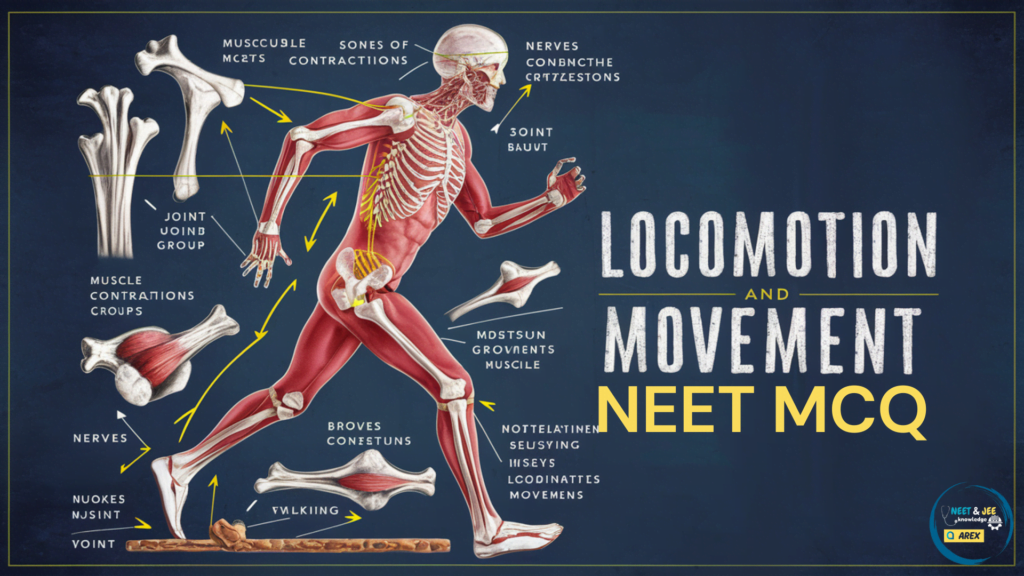
Locomotion and Movement MCQ Biology for NEET
Locomotion and movement are essential for the survival of animals. Locomotion refers to the ability to move from one place to another. This can be seen in activities like walking, running, swimming and flying. Movement, on the other hand, includes all types of body movements, such as the beating of the heart, the contraction of muscles and the motion of internal organs. These actions are vital for various bodily functions, including circulation, digestion and respiration.
The human body has different types of muscles that help in movement and locomotion. Skeletal muscles are responsible for voluntary movements like walking and lifting objects. Smooth muscles are found in internal organs and help with involuntary movements like the digestion of food. Cardiac muscles, found in the heart, pump blood throughout the body. Joints and bones work with muscles to enable movement. Understanding how these systems work together is important for NEET students, as it forms a significant part of the human physiology syllabus.
| NEET 2025 Exam Important Links | |
|---|---|
| NEET 2025 Updated Syllabus | NEET Eligibility Criteria 2025 |
| Biology Preparation | Chemistry NEET Preparation |
| NEET Preparation tips for 2025 | NEET Result 2024 |
Locomotion and Movement NEET MCQ

Enhance your preparation with Arexiq’s Mock Test Series where we provide solutions to various MCQs like we provide in this post “Locomotion and Movement MCQ for NEET”. Our expert teachers explain the concepts thoroughly, making it easy for you to understand. We offer many types of questions ensuring a clear grasp of concepts.
FAQs for Locomotion and Movement
Q1: What is the difference between locomotion and movement?
Answer: Locomotion refers to the ability of an organism to move from one place to another, such as walking or swimming. Movement encompasses all forms of physical motion, including voluntary actions like muscle contractions and involuntary actions like the beating of the heart.
Q2: What types of muscles are involved in locomotion?
Answer: Skeletal muscles are primarily involved in locomotion. They are responsible for voluntary movements, such as walking, running and jumping.
Q3: How do smooth muscles contribute to movement?
Answer: Smooth muscles are found in internal organs and are responsible for involuntary movements, such as the contraction of the digestive tract to move food and the regulation of blood flow in arteries.
Q4: What role do cardiac muscles play in locomotion and movement?
Answer: Cardiac muscles are specialized muscles found in the heart. They contract rhythmically to pump blood throughout the body, which is essential for supplying oxygen and nutrients necessary for all forms of movement.
Q5: How do joints and bones facilitate locomotion?
Answer: Joints act as pivot points where two or more bones meet, allowing for flexibility and movement. Bones provide structure and leverage, working with muscles to produce movement and support locomotion.
Q6: What is the significance of understanding locomotion and movement for NEET exams?
Answer: Understanding locomotion and movement is important for NEET exams as it is a significant part of the human physiology syllabus. It helps students grasp how different body systems work together to enable movement and support life processes.
Q7: What are some common disorders related to locomotion and movement?
Answer: Common disorders include muscular dystrophy, arthritis, osteoporosis, and myasthenia gravis. These conditions affect the muscles, joints, and bones, leading to impaired movement and locomotion.
Q8: How do muscles contract to produce movement?
Answer: Muscles contract through the sliding filament theory, where actin and myosin filaments slide past each other, shortening the muscle fibers and generating movement. This process is powered by ATP and controlled by the nervous system.
Q9: What is the role of the nervous system in locomotion and movement?
Answer: The nervous system controls and coordinates movement by sending signals to muscles. Motor neurons transmit impulses from the brain and spinal cord to the muscles, initiating contraction and movement.
Q10: Why is the study of locomotion and movement important for aspiring doctors?
Answer: Understanding locomotion and movement is essential for diagnosing and treating conditions related to the musculoskeletal and nervous systems. It helps aspiring doctors develop a complete knowledge of human anatomy and physiology, which is vital for medical practice.


